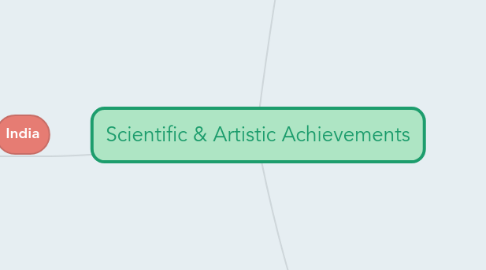
1. India
1.1. Gupta
1.1.1. Artistic
1.1.1.1. Painting, Sculpture, and Architecture
1.1.1.1.1. Ajanta Caves
1.1.1.1.2. Frescoes
1.1.1.2. Language and Literature
1.1.1.2.1. Vedas, Mahabharata, and Ramayana
1.1.2. Scientific
1.1.2.1. Metallurgy
1.1.2.1.1. Description
1.1.2.1.2. Significance
1.1.2.2. Decimal System, Zero, and Pi
1.1.2.2.1. Description
1.1.2.2.2. Significance
2. SEA
2.1. Artistic
2.1.1. Pottery
2.1.1.1. Description
2.1.1.1.1. e.g. Unique Southeast Asian pottery from Ban Chiang, Indonesia and Philippines.
2.1.1.1.2. The techniques of building kilns were learnt from the Chinese.
2.1.1.1.3. People of ancient Southeast Asia were experts in pottery.
2.1.1.2. Significance
2.1.1.2.1. Pottery has been useful in many ways, from transporting water to containing past loved ones, humans have always been relying on potters.
2.1.1.2.2. Historians can study the pottery of a culture and find an array of information about it. Different types of clay can shows the influences a society has or advancements in technology.
2.1.2. Textiles
2.1.2.1. Description
2.1.2.1.1. People of ancient Southeast Asia produced cotton textiles by two special methods - batik (paint) and ikat (bind).
2.1.2.1.2. Traditional textiles are one of the most widely collected and important categories of Southeast Asian art.
2.1.2.1.3. It uses a range of locally produced materials and many techniques, including applique, weaving, batik and embroidery.
2.1.2.1.4. The textiles of Southeast Asia are good in their versatility and originality, and were valuable items of trade.
2.1.2.2. Significance
2.1.2.2.1. Textiles provide a visual history of a country's culture and crafting traditions.
2.2. Scientific
2.2.1. Metallurgy
2.2.1.1. Description
2.2.1.1.1. e.g. Ban Chiang bronze spear-points and iron bangles
2.2.1.1.2. Artefacts revealed that as early as 2000 BCE, the Ban Chiang people already knew the uses of iron.
2.2.1.2. Significance
2.2.1.2.1. Important in architecture and the structures of many buildings. (e.g. so that metals which come into contact with water will not rust.)
2.2.2. Hydraulic Engineering
2.2.2.1. Description
2.2.2.1.1. It is the method to control water supply by using dams, canals, and reservoirs.
2.2.2.2. Significance
2.2.2.2.1. Since water was a precious resource for rice-farming during the dry season, dams, canals, and reservoirs were built to gather, store, and re-direct water.
3. China
3.1. Tang, Han, Song Dynasty
3.1.1. Artistic
3.1.1.1. Painting (Tang & Song)
3.1.1.1.1. Description
3.1.1.1.2. Significance
3.1.1.2. Pottery and Porcelain (Tang & Song)
3.1.1.2.1. Description
3.1.1.2.2. Significance
3.1.2. Scientific
3.1.2.1. Wood-block Printing (Tang)
3.1.2.1.1. Description
3.1.2.1.2. Significance
3.1.2.2. Seismograph (Han)
3.1.2.2.1. Description
3.1.2.2.2. Significance
